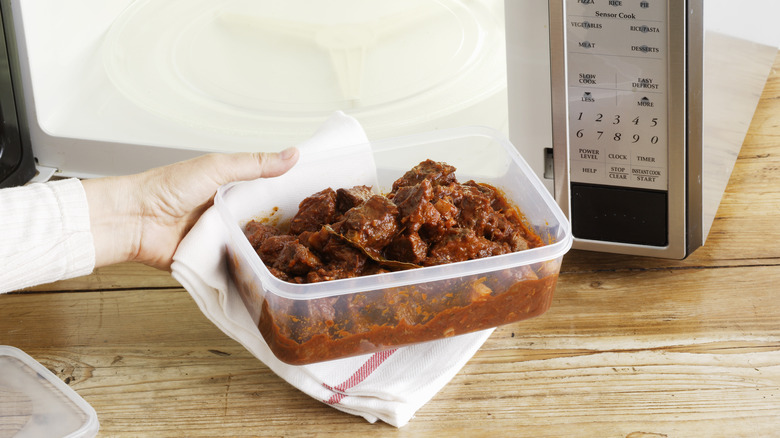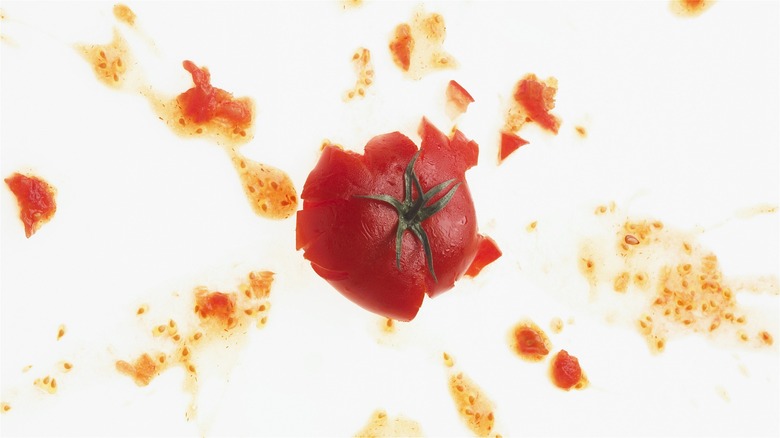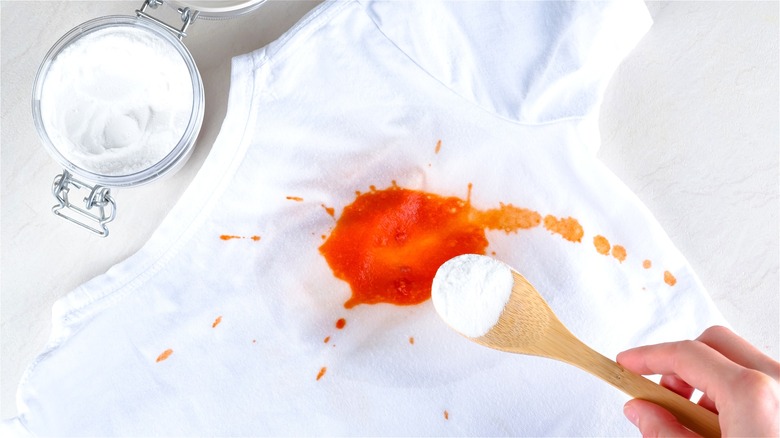How To Finally Get Tomato-Stained Containers Looking Like New
A good marinara sauce recipe should linger in your memory, but not on the sides of your food storage containers. And yet, tomato sauce is one of the foods that most bedevils home cooks with its characteristic orange stains. Why is tomato sauce such a scourge? It has to do with the very thing that makes tomatoes tomatoes: lycopene, a pigment that gives the fruits their bright red and orange colors.
Lycopene plays a similar role with other plants, like pink grapefruits and red cabbage, as well. Pigments aside, lycopene has profound health benefits. It's a carotenoid, an antioxidant that also helps prevent strokes, and consuming it may lower one's risk of developing some cancers, including prostate cancer.
So, don't hate the player — hate the stain. And then, reach under the sink or into your baking drawer, because what you need to get rid of that stain are common household items that you probably already have lying around: baking soda and vinegar (just one or the other — you don't even need both). Simple ingredients, a bit of elbow grease, and a small amount of time: That's all it takes, and pretty soon those tomato stains will be gone.
How to use baking soda and vinegar to get rid of tomato stains
In addition to repelling bad health outcomes, lycopene also repels water — it's hydrophobic, the property that makes it unusually resistant to a good scrubbing. So, how do you get rid of this stuff? One surefire way is to store tomato sauce in something more stain-resistant than plastic, like glass or Pyrex. But if all you've got is plastic, no worries — that just means it's time to bring out the big guns. Bleach? Nah. We're talking about the time-honored, homespun stuff that works miracles in the kitchen, laundry room, and every other room of the house: baking soda and/or vinegar, the dynamic duo that can clean just about anything.
With vinegar, rinse any stray bits of food out of your dirty container and then fill it with a half-and-half mix of vinegar and water. Basic cooking vinegar, like white or apple cider, will work here, as will cleaning vinegar. And, if you're unfamiliar, here's an explanation of the difference between cleaning vinegar and cooking vinegar. Let that sit for up to a day, then dump it out and wash it with soap and water as usual. The stain should disappear.
Alternately, mix baking soda with water to create a paste — add a drop or two of dish soap to superpower the mixture —and then use that to scrub the inside of your stained container. Let it sit on the surface of the stain for up to a half hour before cleaning it out with soap and water.
What else can baking soda and vinegar do?
A better question might be: "What can't baking soda and vinegar do?" And the answer is: not a whole lot, at least when it comes to household cleaning. A paste made of baking soda and water is liquid gold when it comes to scrubbing out a stained kitchen sink, deodorizing a toaster oven, or even shining up grout between tiles. It can take the discoloration out of grimy coffee mugs and stained carafes. You can clean your electric drip coffee maker, meanwhile, with plain white vinegar: Pour up to a quart of it into the reservoir, let that sit for half an hour, then switch the machine on and let it run through its brewing cycle. Then rinse the machine out by running a couple of brewing cycles with plain water.
Vinegar and baking soda can even help fight the other kinds of tomato stains — the ones on your clothing. Mix equal parts vinegar and water and then soak the stain in that, leaving it on the fabric for at least 15 minutes. Then, blot it clean and smear it with a paste of baking soda and water. Rinse and repeat as necessary.


